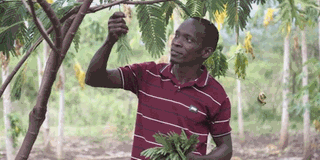Plant acacia tree and earn more money

A farmer prunes excess leaves from the acacia tree on his farm
What you need to know:
- The trees are mainly propagated by seeds which are harvested before the pods are dry to prevent insect attacks. The seeds are usually treated with insecticides and stored in areas where the temperature is maintained at around 10 degrees Celsius. This way, the seeds can be viable for up to 10 years.
The gum Arabic also known as acacia species is a dominant leguminous tree crop that belongs to the family Mimosaceae.
Experts note that there are more than 1,100 species worldwide however, acacia Senegal and acacia Seyal are the most commonly exploited species of the whole acacia family.
They are of African origin and are found to a varying intensity in the gum belt of Sub-Saharan Africa.
Benefits of acacia
Scientists at the Plant Genetic Resources Centre (PGRC) in Entebbe during their routine work of collecting plant species in the wild, realised the gum Arabic in Karamoja is being over harvested by the natives and they feared it can run into extinction.
The team tried to propagate seedlings which they planted at the Botanical Gardens but since central Uganda is not semi dry zone, the plants dried up meaning they can only thrive in semi-arid areas of the country.
It is the reason the scientists are calling on concerted efforts for regional botanical gardens to ensure such plants are conserved within the locality where they can grow well.
Dr Catherine Kiwuka senior research officer at PGRC explains that the gum of the plant is useful in industrial applications such as food and beverages because its fibre is widely used as an additive and stabiliser in foods.
It is commonly used as a thickening agent in icing, fillings, chewing gum and other confectionary treats.
It is also a very commonly used as a base for burning incense because of its light smell.
A number of pharmaceuticals, cosmetics and textiles industries use it in various ways.
The gum tree is known to offer a number of environmental benefits, the most important include its extensive lateral root system that reduces soil erosion and run off and as a leguminous tree it fixes nitrogen which improves soil fertility. Thus degraded soils can be reclaimed through gum Arabic agroforestry that could improve the livelihoods of farming households.
Agronomy
Scientists while relying on a publication from Agronomag publication about how farmers intending to grow the tree should do to get good gum yield give details about the agronomy practices as below.
How to cultivate
The trees are mainly propagated by seeds which are harvested before the pods are dry to prevent insect attacks.
The seeds are usually treated with insecticides and stored in areas where the temperature is maintained at around 10 degrees Celsius. This way, the seeds can be viable for up to 10 years.
Before the seeds are planted, they are soaked or put into a sulphuric acid solution for 15 minutes and they are dropped in boiling water for a few seconds. This process is used to break the seed dormancy.
Vegetative reproduction
This is also possible, through shoot cuttings. The seedlings need to be watered every other time to ensure proper germination.
Although Acacia trees can be grown in nurseries or directly in the field, the trees have a slow-growing rate.
Planting
The field must be prepared before the trees are planted, meaning that it needs a lot of water.
Planting should be made with a minimum spacing of four by four metres in pure stands or 10 by 10 metres in intercropping systems.
Acacia trees can be planted with other crops such as beans, millet or groundnuts. Young plants can attract certain animals, so it is necessary to take preventive measures.
The trees can be tapped after four years, so it takes some time to receive the profits from such a plantation however, they remain productive for up to 20 years.
In addition to their production value, acacia trees can help prevent desertification of certain areas because they serve to stabilize mounds and to act as a windbreak – especially in the case of larger plantations.
The trees are also valuable for agroforestry systems because they can be combined with crops such as sesame, sorghum, millet and groundnuts among others.

Acacia tree blossoms




